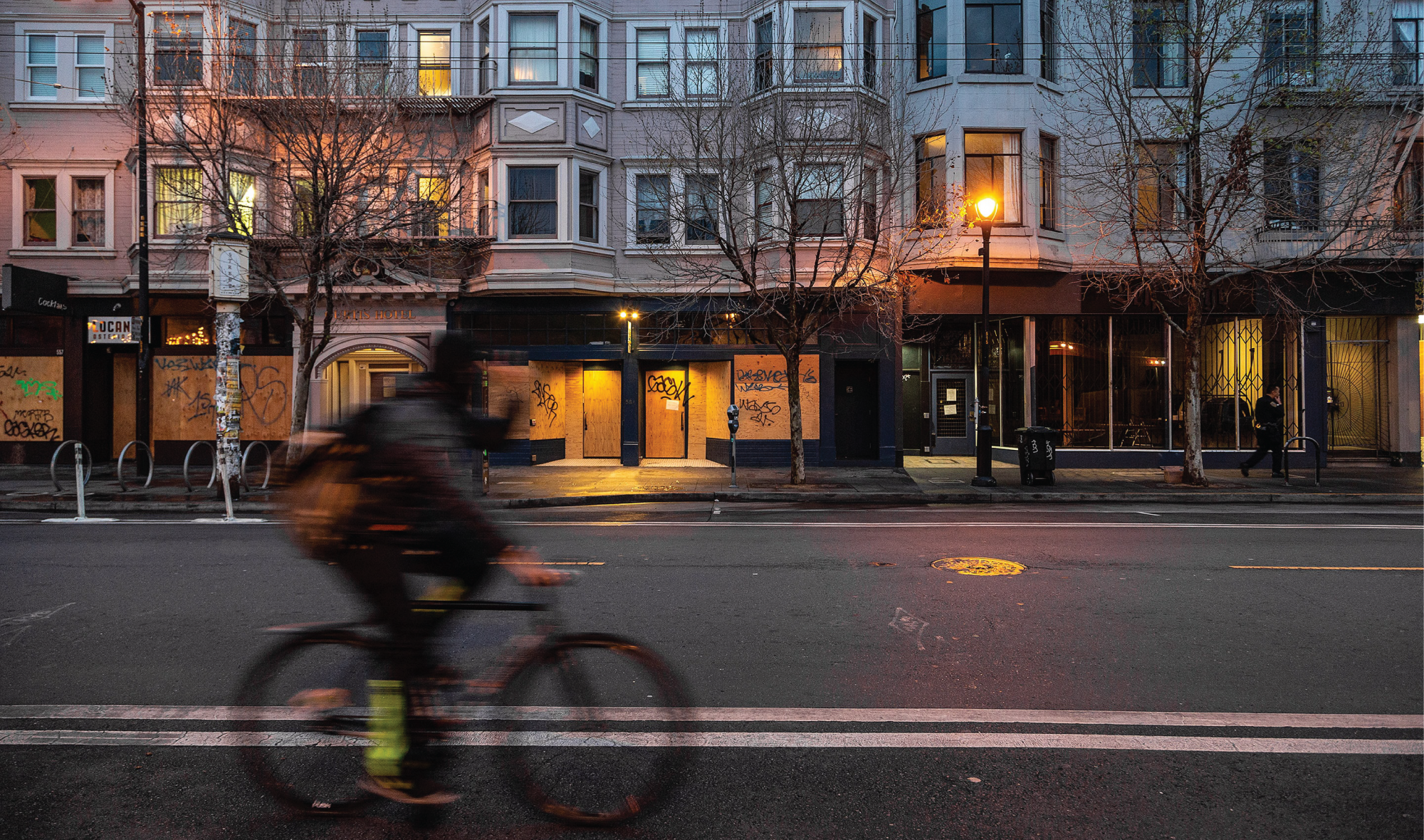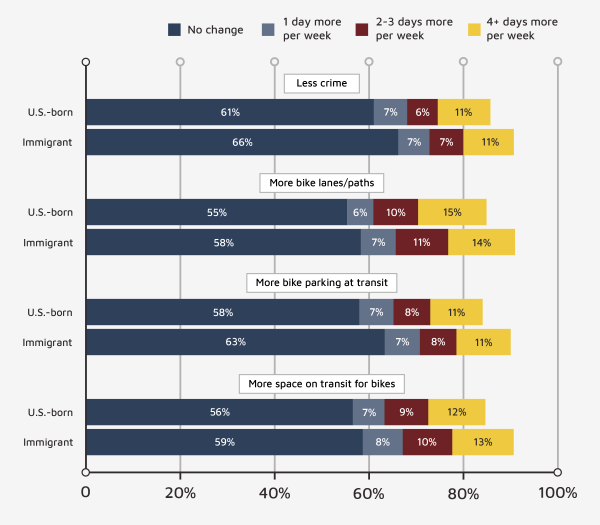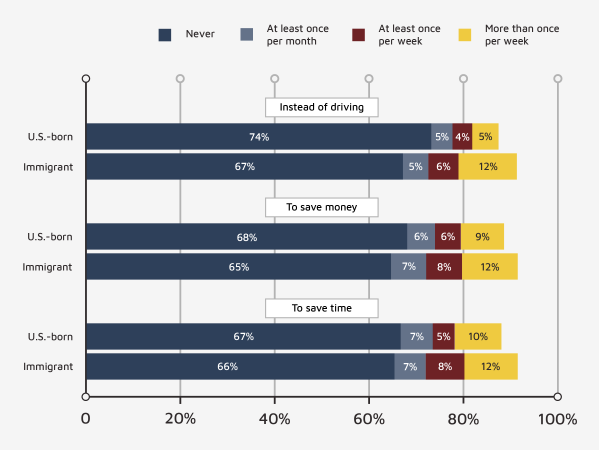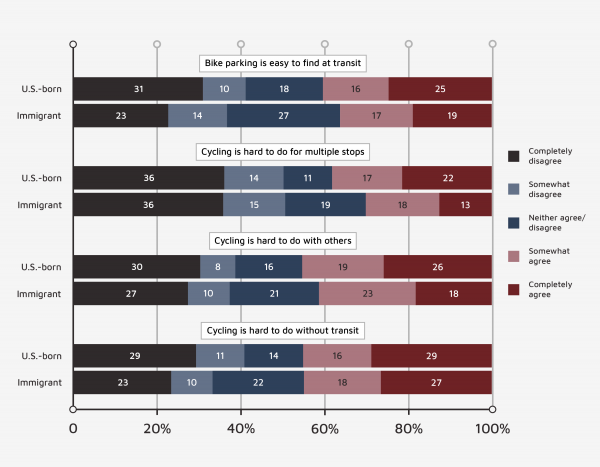
Cycling Toward Mobility Justice in Latino Immigrant Communities
How identity shapes the decision to ride a bike
Bicycling boomed in the early 2000s, and cities both led and responded to this trend. Cities adopted sustainable transportation goals and made infrastructure investments that improved bicycle safety. As the number of cyclists increased, so did their diversity. A 2013 analysis by the League of American Bicyclists and the Sierra Club showed that, between 2001 and 2009, cycling grew much more among people of color: the share of all trips made by bicycle doubled among Black Americans, grew 80% among Asians, and increased 50% among Latinos, compared to just 22% for whites.
This growth of cyclists of color was not uniformly sustained over the following years, however. Cycling continued to grow among Asian populations, doubling from 0.7% of trips in 2009 to 1.4% in 2017. But the growth did not persist among Black and Latino populations. Cycling among Black people halved from 1% of trips in 2009 to 0.5% in 2017. In the Latino population, cycling decreased by a quarter from nearly 1% of trips in 2009 to 0.7% in 2017, ending up about flat over the 16-year period from 2001.
Why the sudden change? No racial or ethnic group is a monolith. This article takes a closer look at cycling within the Latino community, which may help explain why the growth in Latino cycling stalled.
Here is a potentially telling statistic: Between 2001 and 2017, cycling trips to work for U.S.-born Latinos increased by 54%, but decreased by 67% for foreign-born Latinos, with accelerated rates of change for both groups since 2009. Similarly, cycling trips for any purpose increased by 9% among U.S.-born Latinos between 2001 and 2017 but decreased by 28% for Latino immigrants, again with sharper declines for both groups since 2009.
What these statistics suggest is the potentially large role that identity — in this case, immigrant identity — plays in travel behavior. Identity is a complex concept, involving both how people see themselves and how society sees them. While identity by itself cannot cause travel differences, it often has powerful associations with social status, economic outcomes, and personal safety, all of which do help shape travel.
If transportation planners and policymakers fail to recognize how identity can influence travel, they will miss important opportunities to help people meet their travel needs. Planners tend to focus on outcomes that are easier to measure and are at the core of their expertise, such as minimizing travel time and costs, reducing crashes, and increasing accessibility. This focus leads to interventions in the built environment, like bike lanes or traffic calming (such as speed bumps or bollards), which can increase the likelihood of people bicycling.

If transportation planners and policymakers fail to recognize how identity can influence travel, they will miss important opportunities to help people meet their travel needs.

But planners often miss the critical influence that social ties, culture, and experience also have on people’s travel decisions. When they first arrive in the U.S., immigrants often rely on their social networks to get around, and these networks shape the transportation modes that they choose. Cultural narratives, such as taboos and prohibitions for women around cycling, or travel habits from their home countries, may also inform immigrant views on cycling. This sort of information is not readily apparent from simple demographic categories in census data or general travel surveys, so planners rarely factor it into transportation decision-making. Failure to consider these details can inadvertently create conditions for mobility injustice — even if cities provide infrastructure and investment in immigrant neighborhoods, they may still not meet the needs of immigrant communities.
To understand how some of these less tangible factors might explain cycling trends, and what they imply for mobility justice, I conducted a mixed-methods study of how Latinos travel in the San Francisco Bay Area. Together with a team of students, I conducted surveys in English and Spanish of 769 people, both immigrants and U.S.-born, Latino and otherwise, at 44 sites across the Bay Area, including transit stations, bus stops, public plazas, and ethnic businesses. The survey intentionally emphasized Latino immigrants and people whose incomes were lower than the typical household in the Bay Area. Only about a third of respondents had access to a working vehicle and about a third lived in households earning less than $25,000 per year. Immigrants earned even less, with almost half earning less than $25,000.
I used the survey to examine the difference in factors that might influence cycling for immigrants and non-immigrants. The key survey question asked whether a person had bicycled for any reason other than to exercise in the previous week. The questionnaire also collected data on three important categories that I expected to be influential in their decision: individual characteristics, social relationships, and perceptions of bicycling. Individual characteristics included country of origin, race/ethnicity, income, and educational attainment. I measured social relationships via the number of cyclists a person knew, their employment status, whether they lived with roommates, and whether they lived in an immigrant enclave. Finally, I measured perceptions of bicycling by asking respondents if they thought that characteristics of their urban environment made cycling more or less difficult. To measure convenience and safety, for example, I asked respondents if they would have cycled more if their neighborhood had better bike lanes and paths, or if there were less crime around their destinations. I also asked if they bicycled to save time or money and if they used their bikes in combination with public transit. I supplemented the survey data with information on land use, transportation infrastructure, and bicycle crashes near survey respondents’ homes to learn how “bike-friendly” characteristics in their neighborhoods shaped their responses.
Additionally, I conducted 23 in-depth interviews with Latino immigrants who had ridden a bike at some point in their lives. For the most part, survey respondents and interview respondents did not overlap. A few survey participants agreed to be interviewed, but I was more successful in recruiting interviewees with the help of community-based organizations and social service agencies. In the interviews, I asked people about their perceptions of their neighborhoods, why they did or didn’t bicycle, and how they would compare their cycling experiences — for example, in safety, ease, and convenience — to those of other people they knew.
When combined, these methods provided deeper insight than a survey or interview alone — and much more insight than census or other standard travel data — into why immigrants would choose to ride a bike.
Understanding cycling choices
Most of the people in my survey were not regular cyclists. About one in five respondents had ridden a bicycle in the previous week, with no difference between immigrants and U.S-born Latinos. Perhaps because cycling was uncommon, I found few differences in the ways that immigrants and non-immigrants perceived neighborhood cycling conditions, cycling convenience, or cycling ease (Figures 1-3). More than half of both groups said they would not bicycle more often even if there were less crime in their neighborhoods, more bike lanes along their travel routes, more bike parking at transit, or more space on transit for bikes. Immigrants were slightly more likely to bicycle instead of drive if they could, but most did not. About a quarter of both groups cycled to save time or money at least once a month, suggesting that some of the respondents were infrequent cyclists. Of those who responded, most did not report that bike parking, cycling with others, making multiple stops, or using bikes and transit were major barriers to bike use.
Figure 1. Change in the frequency of cycling more if barriers were removed

Figure 2. Frequency of cycling instead of driving to save time or money

Figure 3. Perceptions of bicycling

Why weren’t there differences in how the two groups perceived cycling conditions? Probably the biggest reason, again, was that the vast majority of survey respondents, both immigrant and U.S.-born, weren’t cyclists. About 80% had not ridden a bicycle in the previous week, and their responses indicate that they did not think the characteristics we asked about would encourage them to ride.
Additionally, the respondents tended to live in places with similar built environments — all had dense street networks, comparable accessibility, and roughly equivalent bicycle and transit infrastructure. Since there wasn’t much difference in how much people bicycled or the conditions where they lived, it isn’t too surprising that strong patterns didn’t emerge. Indeed, when I examined the built environment characteristics near respondents’ homes as control variables, the only significant predictor of cycling was the number of road intersections per square kilometer.
Immigrants and non-immigrants did, however, display other differences in how they thought about cycling. First, respondents’ social relationships — also known as their social environments — mattered in different ways within and across the two groups. I considered employment status as part of the social environment because of how strongly social networks play a role in job acquisition for immigrants. Compared to unemployed immigrants, immigrants who were employed were more likely to know other people who used a bicycle regularly. That in turn was a strong predictor of whether or not they rode a bicycle themselves. Among non-immigrants, there was no association between employment status and knowing other cyclists, but cycling predicted knowing other cyclists.
Second, whether or not someone was a cyclist influenced their perceptions of the environment. In other words, if they had bicycled in the previous week, then they were more likely to view neighborhood conditions for cycling favorably and to view cycling as convenient. This relationship between cycling and perceptions of convenience was stronger for immigrants than for U.S.-born respondents.
Third, other transportation modes affected cycling behaviors differently between immigrants and non-immigrants. This was most evident with walking. For those born in the U.S., more walking trips increased the likelihood of cycling, suggesting some reinforcing effects of sustainable travel modes. For immigrants, however, more walking meant they were less likely to bicycle. They were also less likely to get to transit by bicycle. This may mean that cycling is more likely used as a substitute for other travel modes among immigrants; when they can travel by something other than a bicycle, they will. Other studies have shown that the longer immigrants live in the United States, the more likely they are to give up other forms of transportation and start driving; many low-income immigrants follow this pattern in order to get and keep jobs.
Immigrants’ cycling experiences
My interviews with Latino immigrants confirmed some of the patterns contained in the survey data. Everyone we interviewed described how relationships with friends, family, and immigrant-serving community organizations influenced their impressions of cycling. Strong social ties and involvement in cycling communities were critical entry points to a regular cycling habit. In particular, organized social rides were low-pressure and low-stakes ways to build up bike-riding skills and connect novices to experienced cyclists. For example, a mother of two who lived in San Francisco’s Mission District spoke about how such events influenced her children’s experiences on bikes:
My son first got a bike and later, one good thing that happened is that here in [this cycling organization], they began to organize rides with different people from the community where we could go out to places together. This really helped my son gain confidence.
Peer pressure also seemed to play the primary role in introducing people to cycling and motivating them to bicycle. In many cases, the experiences were affirming — visiting bicycle fairs or seeing friends and family post their adventures on social media made people want to join them. But not all such encounters were encouraging. A young man from Guatemala had given up cycling as his primary mode of transportation after his friends’ experiences frightened him away:
Yes, most of my friends have bicycles and the others have cars. They say it’s difficult, that it makes them late and they come back late at night and there are bad people on the street — they rob them, they hit them.
Another person we interviewed talked about how she had always wanted to ride a bike to save money on transportation, but her brother talked her out of it, saying as she put it, “There isn’t much of a culture where drivers respect bicycles and it’s very dangerous.”
These social networks were also critical for providing resources, mobility, and access that low-income immigrants could otherwise not afford. For example, some community organizations run bicycle “kitchens” where community members could use the space as a bicycle workshop, and where some interviewees learned bike repair skills and donated their time to fix up and keep used bicycles. One interviewee shared that the director of the cycling organization he belonged to had given him a free broken bike, and he used the bike kitchen to repair it, which gave him a reliable means of transportation. These resources filled critical needs as safe and educational spaces — one interviewee shared that he and his friends were kicked out of another bike kitchen because they were Latino young adults in a primarily white space.
For some immigrant respondents, transportation habits and negative ideas held over from both their home countries and their new country needed to be overcome before they could adopt cycling as a regular mode of transportation. Some immigrants didn’t see themselves reflected in the kinds of people who were cycling — cyclists were “90% white” in one interviewee’s estimation — a fact they attributed to a lack of cycling habit stemming from the lack of investment in cycling infrastructure in their home countries. Others, especially women, talked about how their cultural narratives discouraged them from cycling. A Mexican woman described the “ancestral taboos from I don’t know how many hundreds of years ago” that would discourage women from riding horses and bicycles, and how that reticence to ride is difficult to overcome. Yet others talked about domestic narratives — how achieving success in America meant owning a car and leaving bicycles behind as “a hobby or simply for fun,” as one interviewee told us.
Our interviewees also described relevant neighborhood characteristics that added detail to our survey findings. Traffic safety and protection from vehicle crashes were the most important factors in deciding to bike or not for many interviewees. Some interviewees wanted more people to start cycling so there was safety in numbers, while many wanted to see infrastructure improvements first, like separated bike lanes, slower traffic, and better pavement quality. These interviews also revealed gender differences in cycling. Men tended to characterize cycling conditions in more positive terms than women, even when describing the same corridor.
For other interviewees, violence and personal security were the main factors that influenced bicycling. Many low-income immigrants have no choice but to live in violent neighborhoods where housing costs are lower. As one interviewee described it:
I don’t go out after 7 at night. I don’t walk on the street for anything. I know another person who bikes. He tells me the same thing, the same — that it’s dangerous, it’s dangerous but we have to use our bikes.
The neighborhood context was another factor weighing into immigrants’ travel decisions. For newly arrived immigrants who spoke little English, learning to navigate their surroundings on a bicycle was joyful, because, unlike being stuck on a transit vehicle, they were free to move about as they wished. But cycling was also challenging because there were no directional signs in Spanish. The intersection of language ability and immigrant status could be particularly threatening for those without documentation to live in the United States and who lack understanding of traffic laws, rules, and norms. “Whatever small error you commit will become a bigger complication for you and your family,” one interviewee explained. He was sensitive to giving police an excuse to stop undocumented immigrants like him for traffic infractions that could end in deportation.
Another relevant neighborhood factor was gentrification. Although the jury is still out on the empirical link between gentrification and cycling, many interviewees believed there was a tight connection between the two. One interviewee living in the Mission District described the tension between planning and demographic changes in her neighborhood:
My neighborhood is more accessible [than my old neighborhood] because Valencia Street [a main thoroughfare] has a bicycle route along the whole street but — these contradictions are very hard. Now that they have put more bike lanes in the neighborhood, the families and children that need them aren’t here anymore. It is super unjust.
Seeking mobility justice
My findings support the idea that Latino immigrant experiences, such as home country travel habits and precarious social position in the U.S., social networks, and neighborhood conditions influence their perceptions of and the desire to use a bicycle. In immigrants’ own words, being an immigrant shapes how others see them when they travel, as belonging or out-of-place, and this, in turn, shapes how they see themselves and their environments. These findings highlight the need to practice transportation planning with a mobility justice framework in mind.

In immigrants’ own words, being an immigrant shapes how others see them when they travel, as belonging or out-of-place, and this, in turn, shapes how they see themselves and their environments.

Mobility justice, as expressed by the Untokening Network, calls for planners and transportation professionals to recognize that “identity influences vulnerability.” As the network explains, those who live under the specter of any number of -isms — racism, sexism, nativism — will have different transportation needs and will require outside-the-box solutions to ensure they can move about safely and freely. Based on the findings in this study, these needs might require transportation agencies to prioritize investments in community cycling groups to strengthen social networks while also investing in infrastructure, incorporating both as central pillars of an equitable bike plan. These investments could support community events like group rides or bicycle festivals, learn-to-ride skills clinics, know-your-rights workshops, and cooperative repair spaces for community members — all examples of initiatives that immigrant community groups have established on their own. Or it might mean pairing crime reduction and cycling safety efforts in ways that don’t subject already-vulnerable groups to additional policing — a thornier problem to solve.
While one study can’t give us the precise reasons for every shift in cycling trends I reported earlier, a mobility justice perspective allows us to ask better questions. Some of the questions relevant for immigrant groups — like how social capital leads to transportation resources — might need to be explored in a different way for U.S.-born cyclists. Other questions may be more salient for different racial groups: Among Black Americans, for example, understanding the role of policing in deterring cycling might rightly take center stage. In any case, closely examining how intersecting identities influence transportation decision-making and developing interventions that acknowledge and account for those identities is a needed first step in developing plans based on equity.